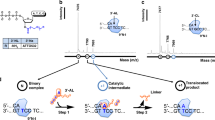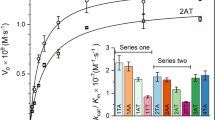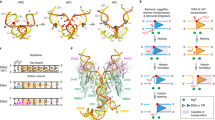Abstract
Runs of adenines (adenine tracts) have been implicated as the main determinant of sequence-directed DNA bending1–4. The most widely used experimental test for bending relies on the observation that bent DNA migrates more slowly than straight DNA on a polyacrylamide electrophoresis gel11–5. It was shown recently that the polymer (G 1111 AAAAC)n runs with normal mobility on a gel, whereas (GAAAA'lTlTC)n runs more slowly and thus appears to be strongly bent6. The observation that these similar sequences, which differ only in the order of the adenine and thymine tracts, adopt such different shapes offers a stringent test of theories to explain DNA bending. Although the wedge model for DNA bending has recently been elaborated7 to explain the gel mobilities of these molecules, we wished to determine experimentally the structural basis for the difference in bending. We report here measurements of the frequency of cleavage by the hydroxyl radical at each nucleotide of cloned versions of the two polymers (see Fig. 1). We show that the TTTTAAAA sequence does not display the cleavage pattern that is associated with bent DNA8, whereas the AAAAlTl 1 sequence does. The observed sequence dependence of the cleavage pattern of an adenine tract is at odds with current models4,7 for DNA bending, which assume that adenine tracts always adopt the same conformation.
This is a preview of subscription content, access via your institution
Access options
Subscribe to this journal
Receive 51 print issues and online access
$199.00 per year
only $3.90 per issue
Buy this article
- Purchase on Springer Link
- Instant access to full article PDF
Prices may be subject to local taxes which are calculated during checkout
Similar content being viewed by others
References
Wu, H.-M. & Crothers, D. M. Nature 308, 509–513 (1984).
Hagerman, P. J. Biochemistry 24, 7033–7037 (1985).
Diekmann, S. & Wang, J. J. molec. Biol 186, 1–11 (1985).
Koo, H-S., Wu, H-M. & Crothers, D. M. Nature 320, 501–506 (1986).
Marini, J. C., Levene, S. D., Crothers, D. M. & Englund, P. T. Proc. natn. Acad. Sci. U.S.A. 79, 7664–7668 (1982).
Hagerman, P. J. Nature 321, 449–450 (1986).
Ulanovsky, L. E. & Trifonov, E. Nature 326, 720–722 (1987).
Burkhoff, A. M. & Tullius, T. D. Cell 48, 935–943 (1987).
Tullius, T. D. & Dombroski, B. A. Science 230, 679–681 (1985).
Nelson, H. C. M., Finch, J. T., Luisi, B. F. & Klug, A. Nature 330, 221–226 (1987).
Coll, M., Frederick, C. A., Wang, A. H.-J. & Rich, A. Proc. natn. Acad. Sci. U.S.A 84, 8385–8389 (1987).
Fratini, A. V., Kopka, M. L., Drew, H. R. & Dickerson, R. E. J. biol. Chem. 257, 14686–14707 (1982).
Drew, H. R. & Dickerson, R. E. J. molec. Biol. 151, 535–556 (1981).
Chuprina, V. P. FEBS Lett. 186, 98–102 (1985).
Chuprina, V. P. Nucleic Acids Res. 15, 293–311 (1987).
Calladine, C. R. J. molec. Biol. 161, 343–352 (1982).
Dickerson, R. E. J. molec. Biol. 166, 419–441 (1983).
Drew, H. R. & Travers, A. Cell 37, 491–502 (1984).
Trifonov, E. N. & Sussman, J. L. Proc. natn. Acad. Sci. U.S.A. 77, 3816–3820 (1980).
Maniatis, T., Fritsch, E. F. & Sambrook, J. in Molecular Cloning, a Laboratory Manual (Cold Spring Harbor Laboratory, New York, 1982).
Tullius, T. D., Dombroski, B. A., Churchill, M. E. A. & Kam, L. Meth. Enzym. 155, 537–558 (1987).
Maxam, A. M. & Gilbert, W. Meth. Enzym. 65, 499–560 (1980).
Author information
Authors and Affiliations
Rights and permissions
About this article
Cite this article
Burkhoff, A., Tullius, T. Structural details of an adenine tract that does not cause DNA to bend. Nature 331, 455–457 (1988). https://doi.org/10.1038/331455a0
Received:
Accepted:
Issue Date:
DOI: https://doi.org/10.1038/331455a0
This article is cited by
-
Chemotherapeutic potential of 9-phenyl acridine: biophysical studies on its binding to DNA
European Biophysics Journal (2010)
-
The role of DNA shape in protein–DNA recognition
Nature (2009)
-
Identification and analysis of functional elements in 1% of the human genome by the ENCODE pilot project
Nature (2007)
-
DNA-bend modulation in a repressor-to-activator switching mechanism
Nature (1995)
-
Processing of Holliday junctions by theEscherichia coli RuvA, RuvB, RuvC and ReeG proteins
Experientia (1994)
Comments
By submitting a comment you agree to abide by our Terms and Community Guidelines. If you find something abusive or that does not comply with our terms or guidelines please flag it as inappropriate.



